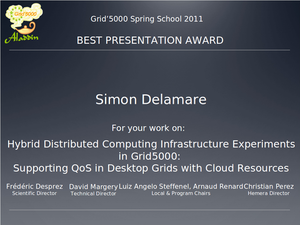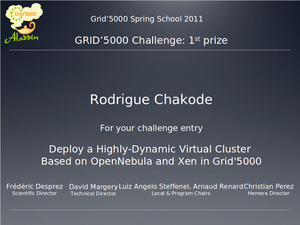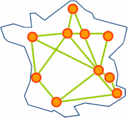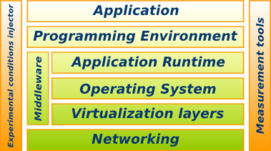Grid5000:Home
|
|
Latest updates from Grid'5000 users
- Experiments
{{#experiments:3|||**}}
- Publications
Five random publications that benefited from Grid'5000 (at least 2927 overall):
- Anna Kravchenko, Sjoerd Jacob De Vries, Malika Smaïl-Tabbone, Isaure Chauvot de Beauchêne. HIPPO: HIstogram-based Pseudo-POtential for scoring protein-ssRNA fragment-based docking poses. BMC Bioinformatics, 2024, 10.1186/s12859-024-05733-6. hal-04234486v2 view on HAL pdf
- Rémi Meunier, Thomas Carle, Thierry Monteil. Multi-core interference over-estimation reduction by static scheduling of multi-phase tasks. Real-Time Systems, 2024, pp.1--39. 10.1007/s11241-024-09427-3. hal-04689317 view on HAL pdf
- Ophélie Renaud, Karol Desnos, Erwan Raffin, Jean-François Nezan. Multicore and Network Topology Codesign for Pareto-Optimal Multinode Architecture. EUSIPCO, EURASIP, Aug 2024, Lyon, France. pp.701-705, 10.23919/EUSIPCO63174.2024.10715023. hal-04608249 view on HAL pdf
- Cassandre Vey, Adrien van den Bossche, Réjane Dalcé, Georges da Costa, Olivier Negro, et al.. Experimenting IoT-Edge-Cloud- HPC Continuum on Existing Platforms. 2025 IEEE 25th International Symposium on Cluster, Cloud and Internet Computing Workshops (CCGridW), IEEE, May 2025, Tromsø Norway, Norway. 10.1109/CCGridW65158.2025.00026. hal-05147272 view on HAL pdf
- Samuel Pélissier, Abhishek Kumar Mishra, Mathieu Cunche, Vincent Roca, Didier Donsez. Efficiently linking LoRaWAN identifiers through multi-domain fingerprinting. Pervasive and Mobile Computing, 2025, 112, pp.102082. 10.1016/j.pmcj.2025.102082. hal-05120767 view on HAL pdf
Latest news
First Cheat sheet created
If you are of those who enjoy a recap of the different commands and links to the main help pages, you'll be pleased to see that an admin has contributed the first Grid'5000 cheat sheet to this wiki. If you wish to understand how it was built, you can read and suggest contributions in the corresponding bug.
Grid'5000 users get 2 out of 3 Best Poster award at IPDPS 2011
Congratulations go to Alexandra Carpen-Amarie ( IRISA, University Rennes 1, INRIA, Rennes, France) for her poster Towards a Self-Adaptive Data Management System for Cloud Environments and to Pierre Riteau (INRIA, IRISA, Rennes, France) for his poster Building Large Scale Dynamic Computing Infrastructures over Distributed Clouds
Grid'5000 Spring School 2011 awards announced
|
Best presentation award to Simon Delamare |
Challenge Winner 2011 to Rodrigue Chakode |
The winning challenge entry demonstrated Deploying a Highly-dynamic Virtual Cluster Based on OpenNebula and Xen in Grid'5000, with SVMSched, and wins an archos Android tablet.
Grid'5000 users selected for the second round of the SCALE'2011 challenge
The following paper has been selected for the second round of the international SCALE'2011 challenge organized in conjunction with the IEEE CCGRID'2011 to be held on May 23-26, 2011 in Newport Beach, CA, USA. M. Djamaï, B. Derbel, N. Melab. A Large-Scale Pure P2P Approach for the B&B Algorithm. (IEEE/ACM CCGRID/SCALE’2011, Newport Beach, USA, May 23-26, 2011).
The paper presents a peer-to-peer Branch-and-Bound algorithm for solving large-scale challenging combinatorial optimization problems. The high scalability of the algorithm is demonstrated through intensive experiments performed on Grid'5000. The work is strongly related to the scientific challenge Large scale computing for combinatorial optimization problems of the INRIA Hemera large wingspan project.
Grid'5000 Tutorial at Renpar'20, to be held in Saint-Malo, May 10th
In the morning, talks will focus on experiment-driven research, open science and how Grid'5000 is a tool to be used in this context. The afternoon will be dedicated to concrete tutorials on how to access and to use Grid'5000. These tutorials will be based on the tutorials available at the Tutorial Home.
Grid'5000 at a glance
- Grid'5000 is a scientific instrument for the study of large scale parallel and distributed systems. It aims at providing a highly reconfigurable, controlable and monitorable experimental platform to its users. The initial aim (circa 2003) was to reach 5000 processors in the platform. It has been reframed at 5000 cores, and was reached during winter 2008-2009.
- The infrastructure of Grid'5000 is geographically distributed on different sites hosting the instrument, initially 9 sites in France (10 since 2011). Porto Alegre, Brazil is now officially becoming the first site abroad.
Sites:
- Grid'5000 is a research effort developing a large scale nation wide infrastructure for large scale parallel and distributed computing research.
- 19 laboratories are involved in France with the objective of providing the community a testbed allowing experiments in all the software layers between the network protocols up to the applications.
The current plans are to extend from the 9 initial sites each with 100 to a thousand PCs, connected by the RENATER Education and Research Network to a bigger platform including a few sites outside France not necessarily connected through a dedicated network connection. Sites in Brazil and Luxembourg should join shortly, and Reims has now joined.
All sites in France are connected to RENATER with a 10Gb/s link, except Reims, for the time linked through a 1Gb/s
This high collaborative research effort is funded by INRIA, CNRS, the Universities of all sites and some regional councils.
ALADDIN-G5K : ensuring the development of Grid'5000
For the 2008-2012 period, Engineers ensuring the development and day to day support of the infrastructure are mostly provided by INRIA, under the ADT ALADDIN-G5K initiative.
HEMERA: Demonstrating ambitious up-scaling techniques on Grid'5000
Héméra is an INRIA Large Wingspan project, started in 2010, that aims at demonstrating ambitious up-scaling techniques for large scale distributed computing by carrying out several dimensioning experiments on the Grid’5000 infrastructure, at animating the scientific community around Grid’5000 and at enlarging the Grid’5000 community by helping newcomers to make use of Grid’5000.
Initial Rationale
The foundations of Grid'5000 have emerged from a thorough analysis and numerous discussions about methodologies used for scientific research in the Grid domain. A report presents the rationale for Grid'5000.
In addition to theory, simulators and emulators, there is a strong need for large scale testbeds where real life experimental conditions hold. The size of Grid'5000, in terms of number of sites and number of processors per site, was established according to the scale of the experiments and the number of researchers involved in the project.
Current funding
As from June 2008, INRIA is the main contributor to Grid'5000 funding.
INRIA |
CNRS |
UniversitiesUniversity Joseph Fourier, Grenoble |
Regional councilsAquitaine |








